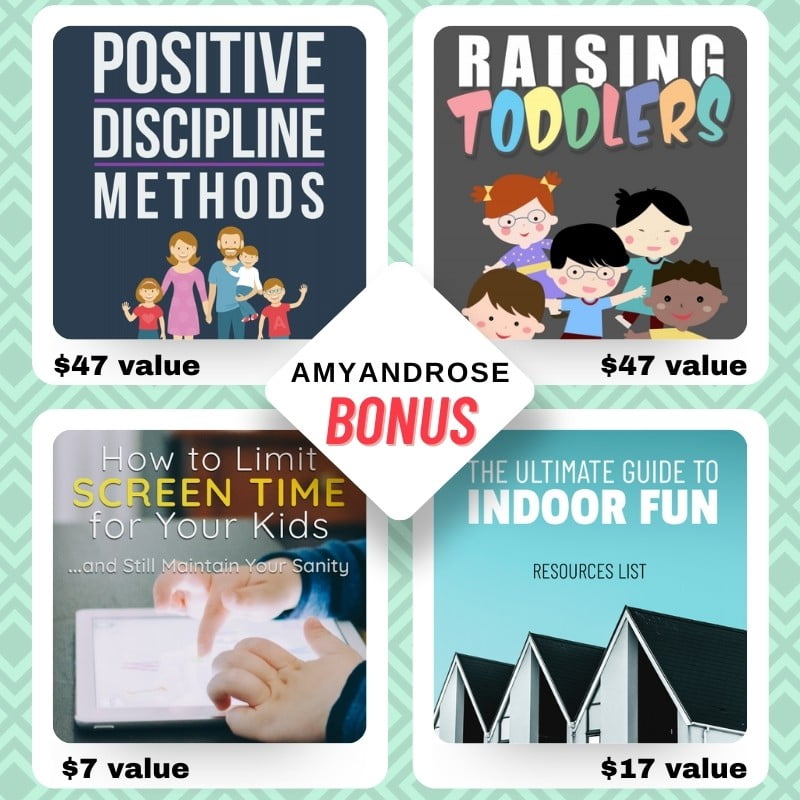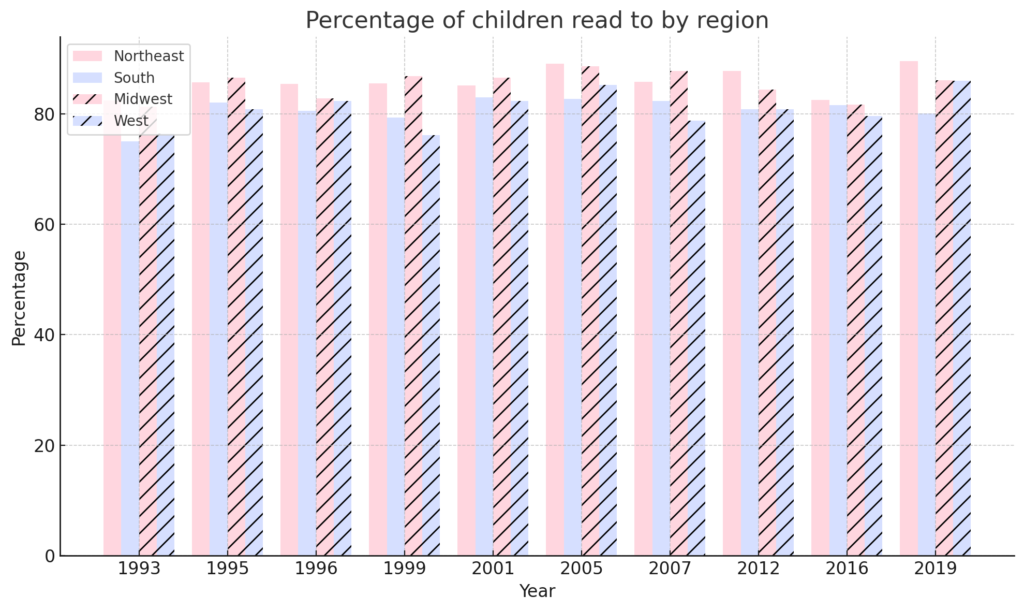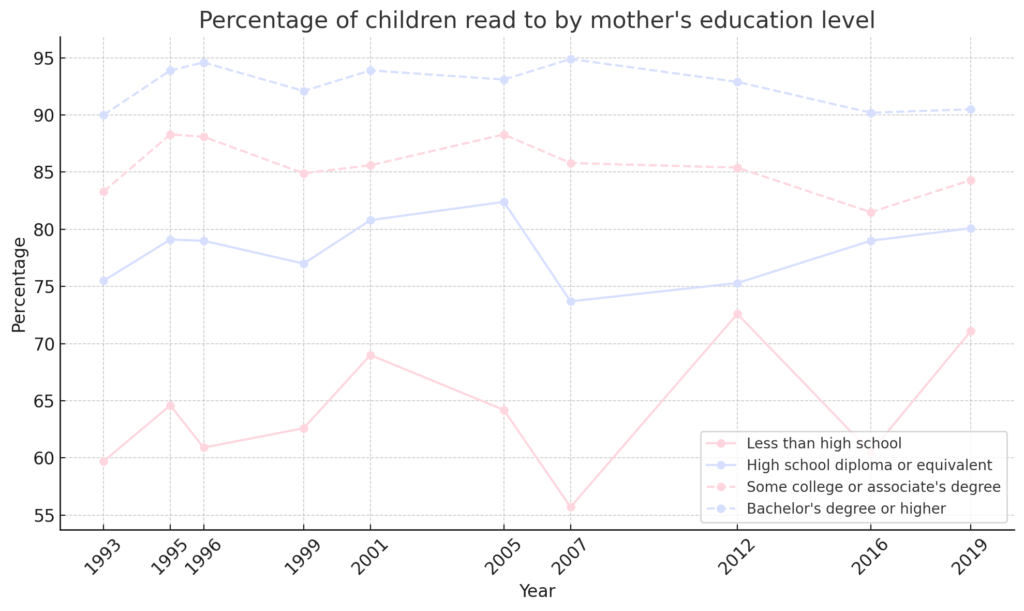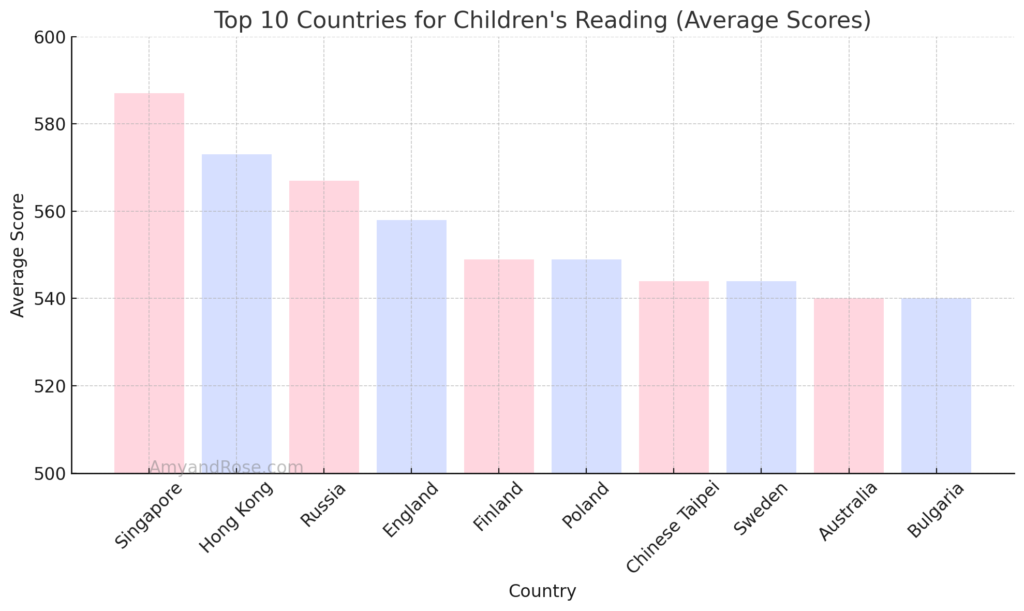Children learning reading is an amazing program that teaches children to read from an early age. Jim Yang designed this program to create a strong foundation for kids. The PDF, audio, and video lessons are available for download from their official website.
The program uses some remarkable phonics and phonemic awareness skills to help children. Check out our full review below for details on everything we liked and didn’t like the program.
Our dedicated editors, writers, and experts carefully choose each product featured on AmyandRose. Should you purchase through links on our website, AmyandRose may receive an affiliate commission. However, please be assured that this does not impact our selection of products.
Time
Commit to 20 minutes per day for maximum potency.
Does it work?
With 75k+ happy parents worldwide, you may find it a safe bet.
Cost
$69 Standard and $89 Premium Plan with multiple bonuses.
Overall rating
⭐⭐⭐⭐⭐
Start your children learning reading trial through the below button. Send your order receipt to [email protected] to receive bonuses worth $100+ as a thank you from AmyandRose.
You can keep these bonuses even if you cancel the trial.


Pros
✔ It works.
✔ Engaging & age-appropriate: The program features playful activities, songs, and interactive elements designed to capture and hold young children’s attention
✔ Easy-to-follow steps.
✔ Builds phonemic awareness: Children develop the essential ability to hear, identify, and manipulate individual sounds in words.
✔ Systematic phonics instruction: The program provides a clear roadmap for children to learn letter-sound correspondences and decoding skills.
✔ Progress tracking features: Parents can easily monitor their child’s progress and identify areas where they might need additional support.
✔ 60-Day moneyback guarantee.
Cons
✖ Potential cost: The program requires an investment.
✖ Requires parental involvement: For optimal results, parents should actively support their child’s learning journey.
✖ May not suit all learning styles: While effective for many, some children may benefit from a more multi-sensory or individualized approach.
✖ Limited independent reading practice: The program may need to be supplemented with opportunities for children to read books independently.
As a mother of two and an Early Childhood Educator with over 15 years of experience, I’ve spent years helping children—including my own—master the art of reading. When I came across the Children Learning Reading program, I was curious but skeptical, given the number of programs I’ve tested professionally and personally.
I decided to try it with my five-year-old daughter, who was struggling to connect letter sounds into words—a common hurdle in phonemic awareness.
The results surprised me.
After just three weeks of using the program’s structured lessons, she went from barely recognizing individual sounds to confidently reading simple CVC words like “cat” and “dog.” One specific challenge was her tendency to lose focus, but the short, interactive lessons—like the rhyming games in Stage 1—kept her engaged.
By the end of the program, she was reading at a level I’d expect from a seven-year-old, and her excitement about books was palpable. This hands-on experience solidified my trust in the program’s approach.
Table of Contents
Overview
There is no denying that parenthood has become the most fulfilling job in this fast-changing world. Each milestone of your children’s development is challenging and demanding.
Raising a child from infancy to adulthood is lengthy and requires much time and effort. In the early stages, parents must teach their children basic skills such as potty training and speaking and reading.
As the kid grows older, parents continue to provide guidance and support.
Every parent knows that the key to success is starting young. After their first word, the next step is to teach them how to read.
According to research, the first five years of your child’s development are crucial. They leave a lifetime effect on your child’s identity.
According to medical science, 90% of your kid’s brain develops when he reaches 3. So, early experiences play a significant role in determining your children’s behavior and attitudes.
By this time, your kid has developed a general sense and is capable of learning new skills.
So this is the golden period when you can encourage your child to learn how to read?
Teaching him reading before school will not only improve his learning abilities but also enhance his self-confidence.
“Today a reader, tomorrow a leader.“
Margaret Fuller
It is essential to develop the skill of reading in your kid early. You can acquire complete training and assistance to do this.
Are you a parent who wants his child to develop his literacy skills before schooling?
Do you want your toddler to start reading at home?
The best reading program to achieve the above goals is children learning reading.
This program is highly effective and has been proven to work. It’s easy to implement in your home, and both infants and toddlers will enjoy participating.
This program will help you to unlock your little one’s potential abilities in a fun and engaging way. To get an insight into this program, let’s dig into its bold features and benefits.

Source: https://www.childstats.gov/americaschildren/tables/ed1.asp?popup=true
Building blocks for reading success: The methodology
The Program uses a powerful phonics tool to help your child become a confident reader. Phonics is all about understanding the connection between the letters they see and the sounds they make.
Think of it like giving your child a secret decoder ring for written words! By learning phonics, your child can sound out new words they encounter, just like a detective following clues.
Building strong readers, brick by brick
The children’s learning reading program is like a jungle gym for young minds. Each lesson is like a new bar to climb, gradually introducing new phonics concepts while making sure they remember what they learned before.
It’s all about building a strong foundation for reading success!
With a Master’s degree in Early Childhood Education and over a decade of teaching young children to read, I’ve reviewed dozens of literacy programs through both a professional and parental lens.
When I evaluated the Children Learning Reading program, I focused on its phonics progression—a critical component of early reading success. The way it starts with basic letter sounds and builds to complex blends mirrors the evidence-based methods I’ve used in my classroom.
As an educator, I also appreciated the printable lessons and MP3 audio clips, which support diverse learning styles—a detail many programs overlook. Having seen the long-term impact of strong reading foundations, I can say with confidence that this program equips parents with practical, expert-aligned tools to help their kids thrive.
Research foundation and scientific context
The Children Learning Reading program’s phonics-based approach aligns with decades of educational research supporting systematic phonics instruction. The Science of Reading, which represents converging evidence from cognitive science, neuroscience, and education research, strongly supports phonics-based methodologies for early reading instruction.
Key research foundations include:
National Reading Panel (2000) findings: The landmark National Reading Panel report identified five essential components of effective reading instruction: phonemic awareness, phonics, fluency, vocabulary, and comprehension. The panel’s meta-analysis of over 100,000 students demonstrated that systematic phonics instruction produces significant benefits for students in kindergarten through 6th grade, with particularly strong effects for kindergarteners and first graders.
Current Science of Reading research: Recent studies show that 95% of students can learn to read proficiently when taught using evidence-based curricula grounded in the Science of Reading. This research emphasizes that effective phonics instruction must be explicit and systematic, providing students with direct instruction in letter-sound correspondences and decoding strategies.
Neurological evidence: Brain imaging studies have revealed that successful readers develop strong neural pathways connecting visual processing areas (recognizing letters) with language processing areas (understanding sounds and meanings). Systematic phonics instruction helps establish these crucial neural connections more effectively than whole-language approaches.
What is children learning reading?

Before diving deep into the review, let’s understand what it is. It is a unique, extensive digital program. It is designed to teach your children how to read in the home environment before their schooling.
It is a complete training program that lays the foundations of reading for children at an early stage of 2 or 3 years.
The program provides step-by-step systematic training to parents. This will be on how they can teach their young children and toddlers to read.
This program intends to give parents and their youngsters complete phonemic and phonic awareness instructions.
Phonemic awareness is different from phonics. Phonemic awareness is learning to hear, identify, and manipulate different sounds in our everyday words.
Before reading the text, children should understand the sounds of the smallest part of regularly spoken words.
Numerous studies have shown that phonemic awareness effectively teaches your child how to decode printed or written words. Further, it helps to manipulate the individual letter sounds and their formation.
A study published by the national reading panel highlights the critical importance of phonemic awareness in early reading success.
The national reading panel suggests phonics and phonemic awareness are far better approaches than other language programs. They are more effective and efficient reading methods than conventional methods of memorization.
Some researchers believe the lack of phonic and phonemic awareness will make reading difficult for kids. Ultimately, it may produce poor readers.
Phonics and phonemics will help your children identify the individual alphabets and their sounds. This enables them to read new and complex words.
This tested formula will help children learn how to read and pronounce advanced and complicated text. It will not only enhance your children’s reading comprehension but also improve their spelling abilities.
Children learning reading program utilizes the incredible strategies of phonics and phonemic awareness. This will aid your child in learning to read and make him a successful fluent reader.
This constructive program is developed specifically for 2 to 6 years old.
This is a valuable learning guide. It has many simple and easy-to-follow steps, audio, videos, worksheets, and more! Your kid will enjoy his whole learning and reading duration.
Children learning reading program format
It is an online program comprised of a 12-week elaborated course that aims at helping your child learn to read.
The program is available in PDF format and divided into two well-structured stages. Both stages consist of 50 coherent lessons. The detailed features of each stage are described below.
The program is meticulously crafted to cater to the unique learning styles and developmental stages of young children. It’s segmented into two comprehensive stages, each meticulously designed to build upon the other and foster a strong foundation in reading proficiency.
Stage 1
Stage 1 comprises 28 lessons and is quite simple and basic. It includes letter recognition and phenomes (the sounds of individual alphabets).
It includes understanding the connection between the letters and their sound.
It also contains notes about struggling readers, short and smooth blending words, the choppy blending of words, and small sentences.
Various stories, fun rhymes, and engaging activities are incorporated to practice each concept.
Stage1 starts with introducing basic and straightforward words. Then these words become more complex and advanced as the lessons progress.
All the activities and stories become more advanced and complex in an intuitive manner. It is done so that your little one will get enough time to fully grasp the whole concept before heading towards the new one.
At the end of stage 1,
Your child can identify and read simple words, small sentences, and short text passages.
Stage 2
Stage 2 consists of 22 comprehensive lessons and is at the advanced level. This stage is based entirely on the skills your young one has developed from stage 1.
Mainly, it focuses on letter combination and blending of letters to make new words.
It also contains advanced-level rhymes and an introduction to new and big letters. Also, it includes a few more complex words, vocabulary growth, sentences, and passages.
After completing stage 2,
Your kid could read more complicated words, sentences, and advanced texts fluently and efficiently.
This stage applies the concepts and skills your kid has already gained from stage 1. It utilizes the understanding of how combining two different letters makes a new single sound. For instance, ‘ch’ in a catch, ‘sh’ in fish, and ‘ck’ in the lock.
All the stories, activities, and rhymes in this stage are more complex and advanced than in stage 1. Again, all lessons and content are arranged and designed in an intuitive style. So, your child can complete each concept successfully in one go.
Overall, the whole program intends to develop a strong foundation and fundamentals of reading before your little one turns 3.
It starts with learning the alphabet and covers the correct pronunciation of letters, words, sentences, and rhymes. The pdf files of the reading program are highly accessible and downloadable.
You can download the whole reading package on your mobile, laptop, tablet, iPad, iPhone, and any other device. So, you can continue the reading process anytime, anywhere you want, without any hassle.
What are the included bonuses?
In addition to the two stages of phonics foundation and advanced phonics, the reading program presents a wide range of bonuses. It offers compelling story lessons, MP3 audio, and kindergarten rhymes.
The premium package of children learning reading also contains video lessons on reading.

The lifetime upgrading of both packages is another incentive for the program. The whole children learning reading program is available on the official website in a digital PDF format. You can get it using the below link.
About the author – Jim Yang
Jim Yang is a Canadian-American reading specialist and the creator of the Children Learning Reading program. As a devoted father of four children and an experienced reading teacher, Jim developed this comprehensive phonics-based program to help parents teach their children to read effectively at home.
Professional Background
Reading Specialist & Teacher
Jim Yang has established himself as a respected reading specialist with a deep understanding of phonics and phonemic awareness methodologies. His expertise lies in creating systematic, parent-friendly approaches to early childhood literacy that produce measurable results.
Program Development Experience
Jim’s journey began when he noticed his own children struggling with traditional reading methods. Determined to find a better solution, he developed a structured phonics program that not only helped his four children become fluent readers but also proved effective for thousands of other families worldwide.
Verified Credentials & Achievements
Practical Expertise
While Jim’s specific educational credentials are not publicly disclosed, his expertise is demonstrated through:
- Extensive practical experience as a reading specialist
- Successful development of research-based phonics instruction methods
- Deep understanding of child development and learning processes for ages 2-6
- Proven ability to create engaging, age-appropriate reading curricula
Teaching Experience
Jim’s teaching background encompasses:
- Years of hands-on experience in reading instruction
- Specialization in phonics and phonemic awareness techniques
- Continuous program refinement based on real-world results and parent feedback
- Focus on creating sustainable, parent-led learning environments
- Expertise in addressing common reading challenges in young children
Professional Recognition
Jim’s qualifications are evidenced through:
- Recognition as a reading specialist in the early childhood education community
- Development of a systematic reading program based on proven educational research
- Successful track record with over 112,000 families worldwide
- Consistent positive outcomes and parent testimonials
- Long-term commitment to improving childhood literacy rates
Collaborative Approach
Jim works closely with his wife Elena Yang in developing and refining the Children Learning Reading program. This collaborative partnership ensures:
- Comprehensive program development from multiple perspectives
- Continuous improvement based on user feedback
- Family-centered approach to early literacy education
- Practical solutions that work in real home environments
Philosophy & Approach
Core Beliefs
Jim Yang’s teaching philosophy centers on several key principles:
- Early Intervention: Believes in the critical importance of teaching reading skills between ages 2-6
- Phonics Foundation: Emphasizes systematic phonics and phonemic awareness as building blocks for reading success
- Parent Empowerment: Focuses on equipping parents with effective tools rather than relying solely on institutional education
- Individualized Pacing: Recognizes that children learn at different rates and provides flexible, adaptable methods
Teaching Methodology
Jim’s approach is characterized by:
- Short, focused lessons (10-15 minutes) designed for young attention spans
- Step-by-step progression from basic letter recognition to advanced reading
- Integration of fun activities, stories, and rhymes to maintain engagement
- Emphasis on practical application and real-world reading skills
Program Success & Impact
Proven Results
Under Jim’s guidance, the Children Learning Reading program has achieved:
- Success with over 112,000 families globally
- Documented improvements in children’s reading abilities within weeks
- High parent satisfaction rates and positive testimonials
- Recognition as an effective alternative to traditional reading instruction
Global Reach
Jim’s program has helped families across multiple countries and cultures, demonstrating:
- Universal applicability of phonics-based instruction
- Effectiveness across diverse learning environments
- Adaptability to different family situations and schedules
- Sustainable impact on early childhood literacy
Personal Motivation
Family-First Approach
Jim’s motivation stems from his personal experience as a father:
- Initially created the program to help his own four children
- Understands the challenges parents face in teaching reading at home
- Combines parental insight with professional expertise
- Maintains focus on practical, family-friendly solutions
Mission & Vision
Jim is dedicated to:
- Making quality reading instruction accessible to all families
- Reducing literacy gaps through early intervention
- Empowering parents to take an active role in their children’s education
- Creating confident, enthusiastic young readers who love books
Continuing Impact
Program Evolution
Jim continues to:
- Refine and update the Children Learning Reading program
- Incorporate new research findings into his methodology
- Respond to parent feedback and changing educational needs
- Expand resources and support materials for families
Educational Advocacy
Through his work, Jim advocates for:
Need for practical, results-oriented educational programs
Recognition of parents as primary educators
Importance of early literacy intervention
Value of systematic phonics instruction
Jim Yang understands the fact that toddlers and young children have a short attention span of 10-15 minutes. So, he designed and arranged the program on short lessons to give quick and productive results to small children.
No lesson of both stages takes more than 10-15 minutes, and some sessions are as short as 2 to 3 minutes. So you only have to take 15 minutes daily from your work and routine for kids to read.
However, the total time of learning depends on your kid. If he is a slow learner, then it may take longer for him to read fluently.
I have a passion for teaching kids to become readers, to become comfortable with a book, not daunted. Books shouldn’t be daunting, they should be funny, exciting and wonderful; and learning to be a reader gives a terrific advantage.
Roald Dahl
Expert opinions and professional perspectives
Professional educator perspectives
Reading specialist viewpoints: While systematic phonics instruction has strong research support, reading specialists emphasize that effective early literacy programs should address the whole child, not just decoding skills. Many professionals advocate for balanced literacy approaches that combine phonics instruction with rich literature experiences, vocabulary development, and comprehension strategies.
Early childhood development experts: Developmental specialists generally recommend that literacy instruction for very young children (ages 2-3) should be embedded in natural, play-based activities rather than formal structured lessons. The National Association for the Education of Young Children (NAEYC) emphasizes developmentally appropriate practices that respect individual differences in learning readiness.
Academic research perspectives: Educational researchers note that while phonics instruction is essential, it represents just one component of comprehensive reading instruction. The “Simple View of Reading” model indicates that reading comprehension results from the interaction of decoding skills AND language comprehension—both areas require development for reading success.
Concerns from child psychologists: Some child development specialists worry about programs that promise early reading achievement, noting that premature academic pressure can sometimes lead to:
- Reduced motivation for reading later
- Increased anxiety around academic performance
- Less time for other crucial developmental activities (play, social interaction, physical development)
Balanced professional recommendation: Most literacy experts suggest that while phonics instruction is valuable, the most effective approach for young children combines:
- Systematic phonics instruction (when developmentally appropriate)
- Rich exposure to quality literature
- Oral language development activities
- Play-based learning experiences
- Respect for individual developmental timelines
Tips used in the program
Following are the tips and tricks that will help your children learn to read effectively.
- Associate the sounds with letters of the alphabet
The first tip is to connect individual alphabets with their sounds, and while saying the sound child can trace the alphabet.
For example, if he is tracing the letter A, tell him the sound of the letter A is ahh. In this way, he will learn both letter recognition and its sound simultaneously. This useful tip utilizes the concepts of phonics and phonemic awareness.
- Set a pattern of text reading
If you are teaching your child how to read a text or page for the first time, then tell him to read the page from left to right or start from the top and end at the bottom. It will help him understand the pattern of reading.
Teach your little one the consonants and their blending. The consonants at the end of some words make rhyming sounds. For example, “at” makes the same sound in the words’ fat’ and ‘cat’.
So this will help them to learn the letters and words with similar sounds, and they can quickly say the sound of similar-sounding words.
- Make reading a fun-filled experience
It is the most important tip while teaching reading to your children. Do not pressure or force them to read. Try to create a friendly environment for his reading and make his reading an enjoyable experience for him. It will develop his interest and love for reading and show a positive attitude.
- Read your children’s favorite stories
To develop a love for reading in your kid, you must read his favorite stories to him and use those words that he likes the most!
Ask about his favorite character in the story, and the best part of the story, and ask him to share his ideas. It will enhance his interest in reading and improve his communication skills too.
All these above tips will help your child to improve his learning abilities and make his journey of learning reading smooth and organized.
Once you learn to read, you will be forever free.
Frederick Douglass
Who can benefit from the program?
The children learning reading initiative is designed specifically for the children of the 2- 6 age group. The program is efficient for even toddlers of 2 years. But your child should have developed proper speech.
It should be kept in mind that this program is not for kids who cannot speak.
So before using this program, you should first make sure that your kid can speak properly. It is a complete learning reading program for toddlers, young children, preschoolers, primary or pre-nursery, kindergarteners, and 1st graders.
The program is not just playing a video on DVD or computer and watching it with your youngsters. It acquires the parent’s involvement and interaction with their children. You only have to take 15 minutes daily from your work routine to help your kid become a fluent reader within a short period.
Jim Yang prefers this program for children between the ages of 4-5 as these children have more attention spans and are faster in cashing on their learning abilities, and are enthusiastic about learning new things and words.
The children of this page are just like a blank page where they have not picked up any bad habits or wrong pronunciation of words, so this is the best time to teach your youngsters phonemic awareness.
The reading program is useful for first and second-graders as well. If your child is in grade 1 or 2 and is lagging due to weak reading abilities, then you can use this incredible reading program.
It will help him improve his reading and comprehension capabilities and boost his communication skills to interact with others.

Source: https://www.childstats.gov/americaschildren/tables/ed1.asp?popup=true
Developmental considerations and age appropriateness
While the Children Learning Reading program targets ages 2-6, it’s important to understand typical developmental milestones and individual readiness factors:
Typical reading development timeline:
- Ages 2-3: Most children are developing basic language skills, learning to speak in sentences, and beginning to show interest in books through pictures and stories
- Ages 3-4: Children typically begin recognizing some letters, especially those in their names, and may start understanding that print carries meaning
- Ages 4-5: Pre-reading skills emerge, including phonemic awareness, letter recognition, and understanding of print concepts
- Ages 5-6: Most children are developmentally ready for formal reading instruction
Expert perspectives on early reading: Educational experts note varying opinions about teaching reading to children as young as 2-3 years old. Some developmental specialists express concern that formal reading instruction at ages 2-3 may be premature, as children at this age are typically focused on fundamental developmental tasks like language acquisition, social-emotional development, and basic motor skills.
Individual readiness indicators: Rather than focusing solely on age, parents should look for signs of reading readiness, including:
- Interest in books and stories
- Ability to sit and focus for short periods
- Recognition that print has meaning
- Beginning phonemic awareness (hearing rhymes, initial sounds)
- Basic oral language development
Balanced approach recommendation: While some children may benefit from early exposure to letter sounds and simple reading concepts, experts generally recommend that instruction at ages 2-3 should be play-based and follow the child’s natural interests rather than following a rigid curriculum structure.
Developmental Readiness by Age Groups
Ages 2-3 Years (Toddlers)
Typical Development Milestones:
- Look at pictures and name familiar items
- Answer simple questions about what they see in books
- Recognize covers of favorite books
- Begin to understand that books have a specific orientation
- Start pretending to read by turning pages
Readiness Indicators for CLR Program:
- ✅ Ready if: Child can sit for 5-10 minutes with a book, shows interest in stories, can follow simple instructions
- ⚠️ Caution if: Child cannot speak in 2-3 word sentences, shows no interest in books, has difficulty focusing
- ❌ Not ready if: Child cannot speak clearly, shows signs of developmental delays, becomes distressed during book activities
Expert Concerns: Many early childhood specialists question formal reading instruction at ages 2-3, as children are typically focused on fundamental developmental tasks like language acquisition and basic motor skills.
Ages 3-4 Years (Preschoolers)
Typical Development Milestones:
- Know correct way to hold books
- Understand left-to-right reading direction
- Begin noticing rhyming words
- Start matching letter sounds to letters
- May recognize their name in print
Readiness Indicators for CLR Program:
- ✅ Ready if: Shows phonemic awareness (recognizes rhymes), can identify some letters, demonstrates sustained attention
- ⚠️ Proceed with caution if: Shows inconsistent interest, has difficulty with sound discrimination
- ❌ Not ready if: Shows no letter recognition, cannot distinguish between different sounds
Ages 4-5 Years (Pre-K/Kindergarten)
Typical Development Milestones:
- Match letters to sounds they represent
- Identify beginning, middle, and ending sounds in words
- Start sounding out simple words
- Begin recognizing sight words
- Use story language in play
Readiness Indicators for CLR Program:
- ✅ Optimal age range: Most children are developmentally ready for systematic phonics instruction
- ✅ Strong indicators: Shows phonemic awareness, recognizes most letters, demonstrates reading interest
- ⚠️ Monitor progress if: Child shows frustration with formal instruction, prefers different learning approaches
Ages 5-6 Years (Kindergarten/First Grade)
Typical Development Milestones:
- Learn spelling rules
- Increase sight word recognition
- Improve reading fluency
- Use context clues for unfamiliar words
- Connect reading to personal experiences
Readiness Indicators for CLR Program:
- ✅ Excellent fit: Children at this age typically benefit most from systematic phonics instruction
- ✅ Strong foundation: Can build on established pre-reading skills
- ✅ Academic preparation: Aligns with formal school reading instruction
Learning Styles and Individual Differences
Visual Learners (Approximately 65% of children)
Characteristics:
- Learn best through seeing and observing
- Prefer pictures, charts, and visual demonstrations
- Remember information better when it’s presented visually
- May struggle with purely auditory instruction
How CLR Accommodates:
- ✅ PDF format with visual letter-sound associations
- ✅ Printable worksheets and visual materials
- ❌ Limited interactive visual elements compared to digital programs
- ❌ Minimal use of colors and engaging graphics
Recommendations for Visual Learners:
- Supplement with colorful flashcards
- Use visual letter formation activities
- Create visual progress charts
- Incorporate drawing and art activities
Auditory Learners (Approximately 30% of children)
Characteristics:
- Learn best through listening and hearing
- Remember information through repetition and rhythm
- Benefit from rhymes, songs, and spoken instruction
- May struggle with silent reading initially
How CLR Accommodates:
- ✅ MP3 audio clips for letter sounds
- ✅ Emphasis on phonemic awareness (hearing sounds)
- ✅ Parent-child verbal interaction required
- ✅ Includes nursery rhymes and stories
Recommendations for Auditory Learners:
- Emphasize the audio components
- Create songs for letter sounds
- Practice verbal repetition
- Read aloud frequently
Kinesthetic Learners (Approximately 5% of children)
Characteristics:
- Learn best through movement and hands-on activities
- Need to touch, manipulate, and move while learning
- May have difficulty sitting still for lessons
- Benefit from multisensory experiences
How CLR Accommodates:
- ❌ Limited hands-on activities
- ❌ Primarily sitting-based instruction
- ❌ Minimal movement integration
- ⚠️ May not be optimal for highly kinesthetic learners
Recommendations for Kinesthetic Learners:
- Add tactile letter tracing (sand, textured surfaces)
- Incorporate movement games with letters
- Use manipulatives like letter blocks
- Take movement breaks between lessons
- Consider supplementing with more hands-on programs
Mixed Learning Styles (Most Children)
Reality Check: Research shows that the vast majority of children have a combination of all learning styles, and some educational research questions the effectiveness of teaching to specific learning styles.
Best Practices:
- Use multisensory approaches when possible
- Observe which methods work best for your individual child
- Be flexible in adapting the program
- Combine CLR with supplementary activities that address different learning preferences
Critical Assessment: Strengths and Limitations
Strengths
- Research-Based Approach: Uses systematic phonics instruction supported by the National Reading Panel findings
- Age-Appropriate Lessons: Short 10-15 minute sessions suit young attention spans
- Parent Involvement: Provides clear guidance for non-educator parents
- Systematic Progression: Builds skills logically from basic to advanced
- Accessibility: Digital format allows flexible scheduling
Limitations
- Limited Age Appropriateness: May be too formal for 2-3 year olds
- One-Size-Fits-All: Doesn’t accommodate different learning styles equally
- Lack of Independent Validation: No peer-reviewed studies on the specific program
- Parent Dependency: Requires consistent, skilled parent involvement
- Limited Multisensory Elements: May not engage all types of learners effectively
Recommendations by Child Profile
Best Suited For:
- Children ages 4-6 with demonstrated reading readiness
- Families who can commit to daily 15-minute sessions
- Children who respond well to structured, systematic instruction
- Parents comfortable with direct teaching methods
- Children showing phonemic awareness and letter recognition
Consider Alternatives If:
- Child is under 3 and showing no reading readiness signs
- Child becomes consistently frustrated or resistant
- Family cannot maintain consistent daily practice
- Child is primarily kinesthetic learner
- Child needs more multisensory or play-based approaches
Supplementation Recommended For:
- Kinesthetic learners (add hands-on activities)
- Children needing more visual engagement (add colorful materials)
- Children requiring social interaction (add group reading activities)
- Children needing comprehension focus (add story discussions)
An overview of the included topics
Reading should not be presented to children as a chore or duty. It should be offered to them as a precious gift.
Kate DiCamillo
After going through the details, let’s take a review of topics that this program offers,
- Build the fundamentals of reading and learning.
- Includes synthetic phonics and phonemic awareness, the connection between alphabets and their sounds, and how children can relate the sounds of individual letters with everyday spoken words.
- Focuses on comprehension abilities and enhances their reading fluency.
- Make children’s reading and learning process swift, simple, smooth, and shorter.
- Utilizes the strategies of blending and letter combination.
- Introduction to simple and complex advanced words.
- Incorporates fun activities to learn and practice.
- Short and fascinating stories and nursery rhymes.
Pricing plans – How much will it cost?
Children learning reading program is available in two accessible versions
- Standard plan
- Premium plan
Start your trial through the below button and send your order receipt to [email protected] to receive bonuses worth $100+ as a thank you from AmyandRose. You can keep these 4 bonuses even if you cancel the trial.

Let’s check out the bold features of each plan it offers.
Standard plan
It is a complete package of reading courses containing everything you want for your child, teaching him how to read. This basic plan costs $69 only. The following are features offered by the standard package.
- Stage 1
- Stage 2
Bonuses it offers
- Stage 1 short lesson stories
- Stage 2 advanced lesson stories
- MP3 audio clips with letter and alphabet sounds
- Common sight words
- Best children’s nursery rhymes
- Program upgrades
Premium plan
This plan comes with four additional lessons, and the total cost is $89. The premium package contains all the features of the standard package and some additional training material as well. This plan offers:
- Stage 1
- Stage 2
- Stage 1 lesson stories.
- Stage 2 lesson stories.
- Complete alphabets and letter sound MP3 Audio.
- Common sight words.
- Children’s ideal nursery rhymes.
- Lifetime program updates.
Bonuses it offers
- Pre-set lesson printouts for stage 1.
- Printout sets for stage 2 lessons.
- Advanced rhymes for stage 2.
- Workshops and one-on-one training sessions for 12 weeks.
Moreover, both plans are available in PDF versions, videos, audio, and consultations.
Refund policy
Jim has full confidence and trust in the potential of his children’s learning reading program. He believes that his reading program will produce 100% brilliant results after its use. You will notice a visible improvement in your child’s reading abilities.

However, if you do not get the desirable results after using this learning program for two months, you can ask for a refund.
Your full payment will be sent back to you according to the reimbursement policy if you are not satisfied with the progress of your kid. Jim Yang offers a 100% money-back guarantee on his reading program within 60 days of your purchase.
Pros
- It is a complete comprehensive e-book that highlights the importance and advantages of early reading and how you can help your child to become a fluent reader.
- It develops synthetic phonics and phonemic awareness and enables him to recognize and differentiate the letter sounds in regular spoken words.
- All the stages consist of easy-to-follow steps and step-by-step training methods.
- All the lessons are short and can completely accommodate the short attention span of your little ones and the workaholic and hectic routines of busy parents.
- It will help to interpret the letter sounds and to demonstrate the correct pronunciation of the individual alphabet.
- Each lesson is productive and extremely effective. You will notice the remarkable progress in your children’s reading and vocabulary growth.
- The program utilizes user-friendly reading strategies and approaches for both kids and parents.
- Offers free additional lessons and bonuses if you buy any of the standard or premium packages.
- The program is highly accessible and pocket-friendly. You can download the PDF format on your computer or your mobile. You can also use the pre-sets of printout lessons available for each stage.
- The program contains a variety of training materials including lesson videos, MP3 audio clips, workshops, colorful pictures, images, digraphs, fun stories, rhymes, and one-to-one counseling sessions.
- Each lesson is less time-consuming, precise, engaging, and entertaining.
- The program offers a 100% payment-back guarantee within 60 days of your purchase if you are not satisfied with the results.
- The product is highly affordable and cost-effective as compared to the other language programs.
- It offers a trial package of 14 days for $9.
- It’s a digital product, there is no physical product that saves the shipment charges.
- The program has highlighted the significance of reading that reading at an early age will not only contribute to your little one’s academic achievements but also boost their sense of creativity and imagination.
Cons
Apart from the numerous benefits of the children learning reading solution, it has a few drawbacks that are given below.
- The program acquires the parent’s involvement and their dedicated efforts. You have to spend time with your child daily to help him learn to read effectively and efficiently, but it may become crucial for busy and professional parents to establish a consistent routine outside their busy schedules.
- The program is only available in digital format which can be a drawback as this requires a constant smooth internet connection to go through each stage and lesson.
- The results of the reading program may vary from child to child. Since each child is different and has a different level of understanding, so it might take longer for your child to develop the finest reading skills. If you have high expectations with this program that your kid would achieve everything that you want within an expected time frame, then this program may be an imperfect choice for you from a few aspects.
To learn to read is to light a fire; every syllable that is spelled out is a spark.
Victor Hugo

Implementation guidelines and best practices
Pre-implementation assessment: Before beginning the program, parents should evaluate their child’s readiness by observing:
- Attention span during book reading (can focus for 5-10 minutes)
- Interest in letters and print
- Basic oral language skills
- Ability to follow simple instructions
- Physical readiness (can hold a pencil, point to objects)
Optimal implementation strategies:
Creating a learning environment:
- Establish a consistent, quiet space for lessons
- Minimize distractions (toys, screens, noise)
- Ensure good lighting and comfortable seating
- Have materials organized and easily accessible
Pacing and flexibility:
- Follow your child’s lead—some days may require shorter sessions
- Repeat lessons if child hasn’t mastered concepts
- Don’t rush to meet artificial timelines
- Take breaks if child shows frustration or resistance
Supporting struggling learners:
- Break lessons into smaller segments
- Use additional visual aids or manipulatives
- Incorporate movement and multisensory activities
- Consider whether child needs more time for developmental readiness
Motivation and engagement:
- Celebrate small successes
- Use positive reinforcement consistently
- Connect reading to child’s interests
- Make learning feel like play rather than work
Warning signs to watch for:
- Consistent resistance or tears during lessons
- No progress after several weeks of consistent practice
- Child expressing negative feelings about reading
- Physical complaints (headaches, eye strain) during lessons
When to seek additional support:
- If child shows no progress after 6-8 weeks of consistent implementation
- If there are concerns about vision or hearing
- If child demonstrates signs of learning difficulties
- If family stress around lessons becomes significant
Reviews from parents
I am a mother of two and I found this program to be very helpful in teaching my kids how to read. It is effective, engaging, and fun.
Julia S.
I have been using this program to teach my kids how to read, and it has helped me a lot. It is well-designed and very helpful.
Samuel R.
I had tried many other programs before but nothing was as good as children learning reading. It is the best reading program that offers results in just a few days!
Nicholas S.
I received the program as a gift from my sister, and I am very happy with it. It is a well-built reading program that has helped me teach my kids how to read.
James W.
I was amazed at the results of this program! My son began fluent reading within few days after using the program!
Samantha M.
I have been working in early childhood education for a while and I can honestly say that this is one of the best reading programs. It has simple, straightforward instructions.
Jennifer R.
It’s an highly effective method that does not require ample time from busy parents. My experience with the entire program has been amazing so far.
Chales H.
My son used to get frustrated when trying to read, but this program has made it fun for him. He loves the games and songs, and now he’s so proud when he can sound out new words!
Barbara J.
As a former kindergarten teacher, I was looking for a way to support my daughter’s reading skills at home. This program aligns with effective teaching methods and has helped her confidence blossom.
Andy E.
Our daughter has some auditory processing challenges, and we were worried about her reading development. This program’s focus on breaking words into sounds has been a game-changer for her.
Sam P.
Critical assessment and potential limitations
Independent research verification: Currently, there are no peer-reviewed academic studies specifically evaluating the effectiveness of the Children Learning Reading program. While the program’s phonics-based approach is supported by research, the specific curriculum and methods used in CLR have not been independently validated through controlled studies.
Expert concerns and considerations:
Age appropriateness debate: Some early childhood education specialists question whether formal reading instruction is appropriate for children as young as 2-3 years old. As one expert noted, programs targeting this age group may “feed on parental fear that ‘if my child isn’t reading by age 2 or 3’—when they are generally working towards potty-training—’my kid is behind.'” This concern highlights the importance of considering developmental appropriateness over accelerated academics.
Individual learning differences: The program’s structured approach may not accommodate all learning styles or developmental timelines. Children develop reading readiness at different rates, and some may benefit more from play-based literacy activities rather than systematic instruction.
Parent commitment requirements: The program requires consistent daily engagement (10-15 minutes) from parents over 12 weeks. This level of commitment may be challenging for busy families or those with multiple young children.
Limited diversity in learning approaches: The program primarily uses one instructional method (systematic phonics). Children with different learning preferences or processing styles might benefit from multi-sensory approaches that incorporate visual, auditory, and kinesthetic elements more comprehensively.
Assessment and progress monitoring: The program appears to lack formal assessment tools to help parents identify when children are struggling or need additional support. This could lead to frustration if children are not progressing at the expected pace.
Long-term outcome data: While the program claims to teach children to read, there is limited information about long-term reading outcomes, comprehension development, or love of reading that extends beyond the initial instruction period.
How does the program compare to Hooked on Phonics and Reading Eggs?
To give you a full picture, let’s compare the Children Learning Reading program to other popular options like Hooked on Phonics and Reading Eggs.
Hooked on Phonics leans heavily on a gamified approach, with apps and colorful activities that appeal to kids who love screen time. However, its phonics instruction isn’t as systematic as Children Learning Reading’s step-by-step method, which might leave some children needing more structure.
Reading Eggs, meanwhile, offers a broader scope—covering comprehension and writing alongside reading—but its faster pace can overwhelm kids who need to linger on foundational skills like phonemic awareness.
Children Learning Reading stands out with its laser focus on phonics, delivered through simple, parent-led lessons.
That said, it doesn’t include the flashy multimedia elements of its competitors, which could be a drawback for tech-savvy learners. For parents seeking a no-nonsense, highly structured program, Children Learning Reading is tough to beat—but if your child thrives on variety or independent learning, you might explore the alternatives.
Children Learning Reading vs. Major Competitors
Hooked on phonics:
- Similarities: Both use systematic phonics approach
- Key Differences: Hooked on Phonics incorporates more gamification and interactive elements, while CLR focuses on direct instruction
- Target Age: Hooked on Phonics typically starts at age 3-4, while CLR claims effectiveness from age 2
- Cost Comparison: CLR ($69-89) vs. Hooked on Phonics (subscription-based, ~$12.99/month)
Reading eggs:
- Approach: More comprehensive digital platform with games, animations, and interactive lessons
- Scope: Covers broader curriculum including math concepts alongside reading
- Pace: Faster progression through concepts with more varied activities
- Age Range: Designed for ages 2-13 with differentiated content levels
Teach Your child to read in 100 easy lessons:
- Methodology: Similar systematic phonics approach using DISTAR method
- Format: Traditional book format vs. CLR’s digital multimedia approach
- Parent Training: Requires minimal parent training vs. CLR’s more detailed parent guidance
- Cost: One-time book purchase (~$20) vs. CLR’s digital program cost
ABCmouse:
- Scope: Comprehensive early learning platform covering multiple subjects
- Approach: Game-based learning with adaptive pathways
- Reading Component: Integrated reading instruction within broader curriculum
- Subscription Model: Monthly subscription vs. CLR’s one-time purchase
Effectiveness considerations: Research suggests that program effectiveness depends heavily on consistent implementation, parent engagement, and child readiness rather than the specific program chosen. The most effective programs share common characteristics: systematic phonics instruction, regular practice opportunities, and appropriate pacing for individual learners.
Measuring success and setting realistic expectations
Appropriate success metrics by age:
Ages 2-3:
- Shows interest in books and being read to
- Recognizes some letters, especially in own name
- Begins to understand that print has meaning
- Can identify some initial sounds in familiar words
- Demonstrates basic phonemic awareness (rhyming, alliteration)
Ages 4-5:
- Recognizes most uppercase and lowercase letters
- Knows letter-sound correspondences for common letters
- Can blend simple CVC (consonant-vowel-consonant) words
- Begins reading simple, highly decodable words
- Shows understanding of left-to-right, top-to-bottom print concepts
Ages 5-6:
- Reads simple sentences with support
- Demonstrates increasing fluency with familiar texts
- Uses phonics strategies to decode unfamiliar words
- Shows comprehension of simple stories
- Begins independent reading of appropriate level texts
Realistic timeline expectations:
- Initial letter recognition: 2-4 weeks for most letters
- Sound-symbol association: 4-8 weeks for basic consonants and short vowels
- Simple word blending: 6-12 weeks, depending on child’s developmental readiness
- Sentence reading: 3-6 months with consistent practice
- Independent reading: 6-12 months, varying significantly by individual child
Warning signs that may indicate need for adjustment:
- No progress in letter recognition after 4-6 weeks of consistent practice
- Persistent difficulty with sound blending after 8-10 weeks
- Emotional distress or strong resistance to lessons
- Physical complaints during reading activities
- Regression in previously mastered skills
Celebrating appropriate progress: Success should be measured against the individual child’s starting point rather than comparing to other children or program timelines. Small, consistent progress is more valuable than rapid advancement that may not be sustainable.
Long-term success indicators:
- Maintains enthusiasm for books and reading
- Chooses to look at books independently
- Uses reading strategies when encountering new words
- Demonstrates comprehension through discussion or retelling
- Shows confidence in reading abilities appropriate to developmental level
When progress appears slow: Remember that children develop reading skills at different rates. Some children may need more time for certain concepts while excelling in others. Patience, consistency, and positive reinforcement are more important than strict adherence to program timelines.
Wrap up
| Name | Children learning reading |
| Author | Jim Yang |
| Rating star | 5 |
| Best for | Kids |
| Bonuses | Pre-set printouts for stage 1 lessons Printout sets for stage 2 lessons Advanced rhymes for stage 2 Workshops and one-on-one training sessions for 12 weeks |
| Pricing | $69, $89 |
| Moneyback guarantee | ✔️ |
| Login | Click here to login |
| Key aspect | Importance rating (1-5 stars) |
|---|---|
| User-friendliness | ★★★★★ |
| Engagement level | ★★★★★ |
| Age-appropriateness | ★★★★★ |
| Interactive elements | ★★★★☆ |
| Visual design and appeal | ★★★★☆ |
| Personalization options | ★★★★☆ |
| Progress monitoring | ★★★★☆ |
| Involvement of adults | ★★★★☆ |
| Cost-effectiveness | ★★★☆☆ |
| Offline usability | ★★★☆☆ |
We conclude here by saying that once your child starts speaking, you should focus on teaching him reading skills. There is no doubt that reading is an amazing tool that widens your horizon of cognitive and thinking abilities.
And this fact becomes more true for the younger ones, who are at an early stage of learning and experiencing the fruitful perks of reading.
To help your child in developing reading skills, you need to choose a program that can effectively utilize your investment of time, effort, and money.
Since the program is a reliable and proven program that has helped up to 75,000 parents over the globe to develop their children’s reading abilities and bring about positive changes in their lives, you can confidently use this program with your children.

Source: https://www.standard.co.uk/news/uk/best-countries-childrens-literacy-reading-stats-b1081496.html
Children learning reading program will not only build a strong foundation for alphabet sounds and their recognition, but it will also help your kid to develop the concept of phonics and phonemic awareness which are the fundamentals of learning how to read.
It is a comprehensive step-by-step guide that will take your child from the basics of reading and phonemic awareness to more advanced learning of words, spellings, sentences, pronunciation, and reading complicated texts in an orderly manner.
The reading program covers every aspect of your children’s learning and reading development. It has broadly covered the social, cognitive, linguistic, and educational aspects of your little one’s development.
Moreover, this program has successfully ended the concept of memorizing the most commonly used words and traditional approaches of pressurizing your young one to learn to read.
Instead, it utilizes an interesting, child-friendly, user-oriented approach, so that reading becomes an enjoyable experience for your children.
Now, if you question why should you prefer the reading program to the thousands of other language and reading programs available on the web? Then we will simply answer this question by saying that this program stands out due to the following reasons:
- 100% unconditional refund policy within 60 days of purchase.
- Low-price trial period.
- Affordable learning reading packages.
- Ease and efficiency of use.
- Short and engaging lessons.
- One-on-one counseling sessions.
- Positive reviews from 75000+ happy parents.
Plus, additional bonuses on the purchase of either package of the learning reading program make it a perfect pick for you and your child to boost his reading fluency.
So if you can manage to spend 10-15 minutes daily with your child to make him learn how to read, then this program is made just for you!
Reading aloud with children is known to be the single most important activity for building the knowledge and skills they will eventually require for learning to read.
Marilyn Jager Adams
Within a few days, you will notice a remarkable improvement in your kid’s reading, pronunciation, and reading comprehension abilities.
So don’t wait further and be the first to grab a copy of the program instantly and get ready to secure a successful and brilliant future for your small child from today!
I hope you like our unbiased review. Please review the FAQs below; I hope we’ve answered all your questions.
Common questions asked by parents
-
Is children learning reading program good?
Do you want your kids to be able to read and understand what they’re reading? If so, then we have the perfect solution for them.
The program will help develop solid foundation skills from which all future learning is built to make it easier than ever before when those early education years come around again!
-
What does a child learn from reading?
A child who reads well will be better at understanding and remembering what they learn from those lessons than someone without that skill set, like math or science for example- but there’s more to learning than just skills acquisition.
Kids also develop a deeper appreciation of themselves as learners by being able to understand things on their terms.
This brings us back around full circle because this self-awareness was one reason why schools began requiring children to start doing homework assignments early (and some still do).
-
Who is Jim Yang?
The man who understands the significance of comprehensive phonics and phenomes concepts that act as building blocks for reading has taught children how to read at an early age since he achieved successful results with his kids.
-
How much time will it take for my child to become a fluent reader using the program?
Well, it depends entirely on your child and his learning abilities. If he is a quick learner, then he can be a fluent reader over less than 12 weeks. And if not, then it might take longer for him to improve his reading abilities.
However, the time prescribed by Jim for most of the children is 12 weeks. With consistent and short reading practice of 10-15 minutes for 12 weeks, you can produce successful readers and get massive fruitful results.
-
Does my child need to have basic knowledge of the alphabet before starting the children learning reading program?
No, the only requirement to start this child reading program before is that your child should be able to speak. All the basics related to the alphabet and its sounds are incorporated into this reading program.
The program consists of 2 comprehensive stages. Your kid will learn all the fundamentals of language, alphabet recognition, and their sounds in the first stage with many fun-engaging stories, rhymes, and activities.
-
How can I get the program for my child?
To get into this program, you just have to follow a few simple steps:
Go to Jim Yang’s official website, go to the product page, and click add to cart, from here, choose the package (standard or premium packages) that you want to purchase.
The features of each foundation package will be displayed with it. Once you select your choice, you will be taken to secure payment methods, such as Visa, MasterCard, or PayPal.
After getting the payment, you will immediately receive the link to download the reading program. Notably, the program is only available online in digital format.
There are no physical products. So you don’t have to wait for the product to arrive at you in days or weeks. You can get it quickly right away on your computers, mobile, smartphones, tablets, laptops, or any other device.
-
Is the children learning reading program approved?
Yes, the program is highly authentic and approved, as it is based on proven research strategies and techniques.
Jim first applied this dynamic reading program to his kids. After getting successful results, he decided to help many other parents who wanted their children to become fluent readers.
Moreover, this reading program has received numerous positive reviews and testimonials from happy and satisfied parents.
You can watch those video testimonials on Jim’s official website, posted by thousands of proud parents showing how this program has improved their children’s linguistic and reading skills within a short period.
-
Is there any free trial option?
No, the reading program does not offer any free trial period. However, you can get enrolled in a risk-free trial of this program.
After paying the payment charges once, you can immediately get access to the whole reading program plus all the bonuses for 14 days. Now, you can get everything in the program for $9 only.
-
Is it too much for my child?
The system allows a young child to learn at their own pace, helping them avoid frustration.
It doesn’t have any age restriction and can be used by kids who lack reading skills, have dyslexia, or have other reading developmental disorders.
The course consists of 10 lessons – it’s very easy to follow, even for parents with little computer experience.
The program is based on the language approach and is meant for parents who wish to teach their children to read. It comes with a risk-free 60-day money-back guarantee and is intended to improve your kid’s academic performance.
-
What is the average age a child learns to read?
The average age a child learns to read is five.
-
How does the program teach children how to read?
The program teaches children phonetic skills and phonic awareness, which are essential in learning how to pronounce letters. It also has instructions on teaching kids strategies for sounding out words and blending them.
-
How to help my child read?
The best way to help your young one read is by reading aloud and talking about the pictures in books with them. There are many teaching methods outlined in the program which can help you further.
-
What if my child doesn’t feel like he wants to learn how to read?
Children have different learning styles, but every child needs to know how. It will help them understand how words work and they can get better grades in school.
-
Do storybooks help with kids’ reading skills?
Reading books is one of the best ways to teach your little one how to read. It’s not only fun, but it also improves their reading skills and grades in school.
-
Should parents force their children to read books?
If you want your child to love reading, then they need to read on their own. The best way is by making sure they have access and are surrounded by books so that they can pick one up at any time.
-
What if my child doesn’t like being read aloud?
A proven technique is to read aloud with your child. Reading together can make it more enjoyable for both of you and will help them learn about different word structures.
-
How does the reading program work?
The program is a systematic training program that focuses on developing efficient reading abilities in toddlers or younger children.
The program utilizes step-by-step lessons, simple, and effective strategies to build the foundations of reading and pronunciation. It consists of easy-to-follow, short, yet powerful, and engaging lessons.
It works on building the concept of phonics and phonemic awareness in your children and then effectively applies this phonemic approach to daily spoken words.
After completing this program, your little one will be able to recognize the sound of each phoneme from the regularly used words and will pronounce it accurately.
-
At what age can I use it for my child?
Learn reading program targets primarily young kids between the age group of 2 to 6 years. Ideally, you can use this program for your young child as soon as he can speak properly.
Jim preferred this program for kids of 2+ age as it is the peak time of learning and experiencing new things.
The children of this age group are more enthusiastic to observe and learn what is happening around them. Moreover, they have a fresh and natural memory, so within a short attention span, they will be able to learn how to read.
The program is recommended for your 2-6-year-old toddlers, preschoolers, kindergarten, nursery, and elementary kids, and also for the students of first and second grade.
-
How much time do I have to spend with my child using it to get the desirable results?
We recommend that you spend at least 10-15 minutes daily with your kid while using this program.
Since the younger children (age 2-6 years) have a short attention span, therefore this duration of 10-15 minutes will be enough for them to complete their one whole reading lesson.
This reading practice of 15 minutes should be arranged daily, as the consistency of lessons will give you a remarkable result.
If you conduct the reading lessons regularly for only 15 minutes, you will see a visible improvement in your child’s reading skills daily.
Every day you will notice a progressive change in your little one, and this will motivate you both to learn more!
-
What is the best age for a child to learn to read?
Every child has a different reading level.
The best age to start teaching your preschooler how to read depends on his or her reading ability and interest in learning new things. So, you must find out what interests them before deciding when is the right time for this first lesson!
-
What are the 5 benefits of reading?
A person can improve their vocabulary, and learn about culture and history in a new land or period (the study of literature). And also, develop skills for writing by comprehending complex material through reading.
Reading also has been linked to improved mental health. It results in fewer feelings when stressed out due to its calming effect on people who have trouble focusing attention at times because they are distracted easily.
-
Is There A deal, coupon code, or discount?
A sale might be happening on the official website right now and you can save nearly 70%!
-
What is an alternative reading program?
You can also check the reading head start program. Do read the review on our blog.
-
Is children learning reading worth it?
Aside from the obvious fact that knowing how to read will open up a whole new world for your child, early reading achievement is a strong indicator of future success.
Children who become fluent readers by the time they finish 3rd grade tend to do better academically. The ones between 3-6 years old learn best through phonics instruction.
The reading program will provide your young kid with early literacy skills throughout the pre-school years, including the ability to decode new words, build vocabulary, learn about sentence structure, and improve reading.
The sooner your child becomes proficient in reading, the sooner he develops the love of reading, which will continue throughout his school years and will pave the way for more academic success and more enjoyment of life. -
How do children learn to read?
Children learn to read through the process of oral language and written language acquisition. They learn the language by listening and talking with adults and their peers.
Kids are also exposed to print in their everyday activities. When a child starts to talk, she connects letters and sounds.
When they hear a new word, they will often match the first letter to the first letter. This is known as whole-word matching. These early steps in reading are called emergent reading.
As children’s knowledge of the alphabet and letter sounds grows, they begin to decode words. Decoding is the step where the child matches the letters in the printed word with the sounds the letters make.
In the early years, they progress from whole-word matching to learning about the relationship between the letters in the printed word and their sounds.
This is known as letter-sound correspondence knowledge. -
Why is reading important for children?
There are many reasons why reading is important for children.
In the classroom, children use reading for learning, for example: checking in their textbooks, reading the lesson material, and reading other materials like a dictionary, vocabulary book, and even the weekly reading homework their teacher gives them.
To gain knowledge at home and on their own time. They can read a book at home and learn new things or read a newspaper and learn about current events.
To develop their reading skills and fluency and to improve their writing.
As they learn to read more, they learn how to express their feelings and thoughts in words and improve their reasoning and critical thinking skills.
To educate themselves, which helps them be prepared for their future.
To develop their language skills by increasing their vocabulary, improving their speaking skills, and teaching them about different sentence structures. -
What is the best reading program for elementary students?
Many different reading programs are available for elementary students, and it cannot be easy to know which one is best.
Some factors you may want to consider include your child’s age, the reading difficulty they come across, and your personal preferences.
For me, the program is the one that understands the difficulties that children face and helps them overcome them. -
How much should I read to my 3-year-old?
Newborns enjoy looking at any book with colorful pages. Toddlers are drawn to books with a lot of movement and sound effects.
When your child is older, books with rhyming words and humor become fun to read. As your child grows even older, reading can become work when reading a text with over 100 words.
It is here that a child learns about written words through instruction and practice. The more words your child is exposed to, the better he will be at reading.
The more children are read to, the more books you will have for your child to read on his own.
If a child is taught to read when he is three and a half years old, he will be able to read simple words and sentences on his fourth birthday. -
Can most 3-year-olds read?
When it comes to child development, every child is different. Some may start reading very young, while others may have more difficulty.
If you’re concerned about your child’s reading development, it’s always a good idea to consult a specialist. -
Why is learning to read important?
Learning to read is the basic foundation for all other kinds of learning.
Instruction in reading should begin when a child is four years old, and he should be given plenty of practice reading nursery rhymes, simple stories, and other materials.
As he grows older, his reading materials should grow more challenging. The rule is that you should always read material one grade level above the child’s age.
If the child is in first grade, the material should be for second graders. For kindergarten, first-grade stuff, and so on. One of the best methods for learning to read is to read aloud to your child.
He will learn the proper way to pronounce words, how to enunciate, how to regulate his voice, how to follow along with a story, and how to follow the rules in general.
The other way to read aloud is to read to your child. If you read to him, then he will be able to learn how to read by himself.
This is very important because it will help him to be comfortable with reading, and it will make him feel confident as well. -
Should my 4 year old be reading?
No definitive answer exists as to whether or not your 4-year-old should be reading, as this depends on various factors.
If your child is older, they may have more difficulty learning to read and may require different reading instruction than a younger child.
Additionally, some children may learn better from printed words, while others may respond better to spoken words. Complex sentences may also be confusing for some.
The most important factor is to use a language method that your child understands and is comfortable with. This may include teaching letter names or simply reading printed text aloud.
Older children may also benefit from reading work designed for high school students. -
How can I improve my child’s reading skills?
Reading is the process of decoding symbols to construct or derive meaning; it is a language-based communication skill. Reading is one of the cornerstone skills of the 21st century.
The essential ability allows you to read street signs, menus, directions, and much more.
Creating an environment where your child feels comfortable reading out loud is important to instill confidence in your child. It is important never to force your child to read out loud.
Instead, this should be a conversation that is always fun. As a parent, you should celebrate their successes and be patient with them when they struggle.
The key to helping your child improve is finding material at their reading level, which is the level where texts are neither too easy nor too difficult for them.
The first stage of learning to read begins with developing oral language skills. It is important to read to your child daily but ensure they are interested in the subject matter. -
What is the advanced phonics manual?
It’s different from the usual phonics you may be familiar with because it is an intensive program with a group approach. It uses repetition to help students learn the sounds of each letter.
Recommended supplementary resources
Additional phonics resources:
- Letter manipulatives: Magnetic letters, letter tiles, or foam letters for hands-on practice
- Phonics games: Simple board games or card games that reinforce letter-sound relationships
- Decodable books: Books specifically written to practice phonics patterns being learned
Supporting materials for comprehensive literacy:
- High-quality picture books: For developing vocabulary, comprehension, and love of reading
- Poetry and nursery rhymes: To enhance phonemic awareness and rhythm
- Environmental print activities: Using everyday text (signs, labels, packages) for real-world reading practice
Assessment and progress monitoring tools:
- Reading readiness checklists: To evaluate child’s developmental appropriateness for instruction
- Simple progress tracking sheets: To monitor letter recognition, sound identification, and word reading
- Portfolio collections: Saving child’s work samples to document growth over time
When to seek professional support:
- Educational consultants: For personalized learning plans or program modifications
- Reading specialists: If child shows persistent difficulties with phonics concepts
- Pediatric developmental specialists: If concerns arise about learning readiness or processing
Community resources:
- Local library programs: Story times, early literacy programs, and reading clubs
- Preschool or kindergarten teachers: For guidance on school readiness expectations
- Parent education groups: For support and shared experiences with other families
Digital resources and apps (supplementary):
- Phonics-based apps: For additional practice (used in moderation)
- Audio books: To develop listening skills and story comprehension
- Educational videos: For visual learners (recommended in small doses)
Creating a print-rich environment:
- Label household items: To connect print with meaning
- Daily reading routine: Beyond formal lessons, regular story time
- Writing materials: Crayons, markers, paper for early writing attempts
- Book accessibility: Age-appropriate books easily available throughout the home















Parents teach their children to read by hiring teachers for their kids, but this program teaches you how to teach your child with various techniques. Children Learning Reading is an excellent online course that helps you in learning everything about phonics.
It is the perfect way to teach your child how to read and write at home. A complete package of fun activities, stories, videos, and audio. I would recommend everyone to use this program.
I would heartily recommend this course to anyone who wants a stress-free, effective way to teach your child to read in only 30 minutes per day. Use this program and see your child learn to read most enjoyably.
I have been teaching young children for fifteen years now and I can confidently say that Jim Yang reading program is a breakthrough in learning the English language. Through my experience, I’ve realized that there was a real need to offer high-quality educational products that meet the needs of parents who are looking for new ways of teaching their children.
This tested formula will encourage them to develop the capability of reading and correctly pronouncing advanced and complicated texts. It will not only enhance your children’s reading skills but also improve their conversational abilities.
In addition, your children will enjoy the new games included in this program. They will not only develop their logical thinking and problem-solving skills but also improve their attention levels. There is no doubt that these benefits are priceless to any family.
Our daughter is very shy and has difficulty in expressing herself. We were concerned that she might have problems learning how to read. Luckily, thanks to Jim Yang’s reading program, she is now able to read with ease and enjoys doing so! She really loves this course!
A lot of parents and teachers have been addressing me for information on my child’s learning method. They are very excited to learn that we were able to teach him how to read when he was only five years old using Jim Yang’s tested and proven reading program.
This course has helped our son with his comprehension and vocabulary skills as well as improving his self-confidence in speaking in public. We are very happy with the results.
I have always been worried about how I can help my child in learning reading at home. This program has made it possible for the first time with the unique method of teaching phonics using stories, videos, audios, etc. My son loves to learn new things about letters and words through this program.
This unique program teaches your child about writing letters in the correct direction while making it more interesting by including stories and audios. The colorful images used in this program make the learning process fun for your son or daughter.
My son has been doing well at school but he had trouble with reading. He really enjoys this course as it is different from other courses that we tried before. He finds the interactive lessons entertaining and uses new words in daily conversations.
I would recommend this course for all children who are having problems with reading as it really works.
I have three children and wanted to start this program as soon as possible. They started reading before the official age as all of them are gifted children. We’ve noticed steady progress in their reading skills since starting the program. First, there was an increase in their interest level when doing the reading lessons.
Then they started to use the new words in their daily life conversations and even talked about them with their friends. I would recommend this program for all people who are interested in education.
Synthetic Phonics Method is an easy and effective way to learn how to read for your child. It makes use of pictures, stories, audios, etc which help in making the learning process faster and smoother.
I would like to tell you how happy I am with Jim Yang’s program! My son used to struggle with his reading lessons but after only a few weeks of using this program, he was able to read a chapter book comfortably. I’m really grateful for such an outstanding course.
In my search for a good reading course, I found out about Jim Yang’s program. Not only is it fun to use but also encourages children to improve their comprehension skills before learning how to read. This increases their ability to remember what they read.
I’ve seen great changes in his reading skills since he started the program. I would recommend this to my friends.
Since starting the program, we’ve noticed a significant improvement in her reading skills along with a lot of excitement during each lesson. Now I don’t have to read books for her at bedtime anymore as she reads them herself during her learning sessions.
This program has helped my child to improve in all areas of education: his grades in school, speech development, and even general knowledge as his focus and concentration levels have improved. I would recommend this program to all parents.
Parents teach their child the alphabet sounds and kids start learning how to read. This program takes a different approach by teaching your kid various phonetic rules for letter recognition, pronunciation and word building, etc. The program comes with easy-to-follow instruction making it perfect for young children. It’s great to Learn from Children Learning reading program.
Teaching Your Child to Write can be a difficult task if you lack the right knowledge and guidance. I am using this program to teach my child how to write small words such as the, is etc. It is very useful for me because it’s highly interactive.
The Stepbystep Lessons of this program are unique and different from the other reading programs. It starts with the alphabet sounds followed by word building, sentence reading, syllable awareness, etc. The colorful images make it more interesting which helps in making learning fun for your child.
Teaching Your Kid to Read is a tedious task if you don’t have the right direction and guidance. This program provides easy to follow lessons with effective techniques which help in teaching your child all the necessary skills for reading.
Child’s ability to learn something new is limitless if you have the right learning techniques and materials. This program does a great job teaching phonics to your child. It helps parents in creating a good foundation for their kids so that he/ she can easily read bigger words and advanced texts later on.
Enhancing the foundational skills is a compulsory part of any reading program which makes the learning process easier and smoother. If a child has a strong phonics foundation, he can easily read big words and difficult texts. This program is very well-designed to teach young children about letter sounds and their correct pronunciation.
This program is an excellent way of choosing different learning materials and methods that are suitable for each child. My son loves this course especially the games and activities.
I started my daughter on this program right after she turned 5. We were very impressed by its different and interesting way of teaching.
System for Teaching Phonics is a highly interactive program that teaches your child about the phonetic sound of letters and their correct pronunciation. I have seen a great improvement in my son’s reading skills after using this program for a few weeks only. This is a Highly Interactive Program with Step by Step Lessons that can be used by any kid of any age.
This program provides easy steps to learn how to write words for their kids which was never possible before. The Program Comes with a 60 Day Money Back Guarantee which makes it risk-free.
The Unique and Interactive Lessons make learning fun for your child. The teaching method is very easy to understand which makes it perfect for kids of all ages.
I recommend this program for all parents, as it makes a difference to your children’s education. The best part about this online course is that you can monitor your child’s progress.
My husband and I bought this program for our 5-year-old son. We immediately noticed an improvement in his reading skills after only a few weeks. It is one of the best investments we have ever made.
It is very important to Teach Children to Read as soon as possible. If you miss this chance, then it will be difficult for the child to learn how to read later on. The fun activities and games included in this program help your kid in learning all the necessary skills fast.
The lessons are easy to follow and attract your child’s attention. The results of the courses were evident in my daughters’ self-confidence since she started reading without any problems.
This is perfect for those parents who love to Teach Reading to their kids. The Program Features a Step-by-Step Reading Program with Interactive Lessons which is very easy to understand for children of any age group.
Something I have never seen before is that the reading lessons do not only focus on teaching a child how to sound out words but also how they are spelled. This is something every parent should know about.
Inside the Jim Yang’s Reading Program, there are many lesson plans designed to teach your child about left-to-right direction. It is very useful if you want your kid to develop good writing skills.
Your style is unique in comparison to other folks I’ve read stuff from. I appreciate you for posting when you’ve got the opportunity, Guess I’ll just book mark this page.
No bells and whistles here, just solid phonics instruction. My son, Liam, needed systematic teaching to make those reading connections. This program delivered. The parent guide was super helpful, lessons were short and focused, and we saw steady improvement. If you want results, not gimmicks, this is a great choice
I am very impressed with the way it is designed for young children. It starts from the letter sounds and gradually goes on to word reading. The activities are also excellent which are highly interactive. The stories are very interesting as well as engaging which makes the learning process smooth for your kids. Highly recommended if you want your kid to learn how to read.
The reading program has made a world of difference for my three-year-old boy. The 28 lesson plans have improved his reading ability and skills tremendously.
My six-year-old daughter, Olivia, was a reluctant reader. She recognized a few sight words, but truly struggled with reading new words on her own. We tried a couple of phonics programs before, but they were confusing for both of us. Then came the Children Learning Reading Phonics program. Its strong focus on phonemic awareness and synthetic phonics was the key!
The lessons built gradually, starting with simple sounds and progressing to more complex blends, really focusing on the core of reading phonics. Olivia found success with decoding sounding out words, which boosted her confidence in tackling longer words. We love the included word lists, especially the frequency words, because they make her feel like she’s reading real books! It’s not a magically instant solution – we’ve worked consistently – but the value for money is absolutely there. If your child is struggling with reading, this could be the structured program you’re looking for!
We were initially skeptical, but we are happy with the reading program. My child has learned how to read in just a few weeks. I’d like to recommend this reading program to other parents.
I was hesitant to spend money on yet another learn to read program, but I’m so glad I took the chance on the Learning Reading program. The price is great for what you get – detailed lessons, a useful parents guide, and even those cute letter sound videos. My son loves repeating after the teacher! His reading and spelling have improved tremendously. It’s worth every penny, and I love that they have a satisfaction guarantee.
Honestly, bedtime stories used to be a bit of a nightmare. My daughter, Emily, loved being read to and would cuddle up all excited for a new book, but as soon as I’d say, “Let’s try reading words together,” her little face would fall. She knew a few sight words by heart, but couldn’t figure out new ones. It would end in tears and frustration for both of us. Her teacher even mentioned she was a little behind on something called phonemic awareness, which just made me feel more helpless.
Then a mom at the playground told me about the program. At first, I was hesitant – we had flashcards gathering dust and a few unused reading apps. But this felt different. It wasn’t just about memorizing, it was like showing Emily the “code” behind reading words. She started making those connections between sounds and letters, and one day it just clicked! She’d point at a page and proudly say, “That says dog!” or “The sign says park!”
It wasn’t always easy – some days were harder than others, and I’d worry if we were making progress. But the program gave me ways to help her without making it feel like a chore. Plus, they really focused on those everyday words like “the” and “in” that she used to stumble over. Now she sees them and reads them without even thinking! We’re not at chapter books yet, but seeing Emily’s confidence grow has been amazing. She even tries reading signs when we’re out and about. This program truly has made a difference for our family.
Unfortunately, the program wasn’t a great fit for my daughter. She’s a very visual learner, and while it did have some pictures, she needed more visual cues. It also felt slow-paced to her. She already knew her alphabet letters and basic letter sounds, so the beginning stages felt repetitive. It might work well for other kids, just not for her specific learning style.
I had such high hopes for this program with my daughter. Everyone raves about phonics, and the program sounded right. But Emily has a short attention span, and it was a fight to keep her on task. It breaks my heart because I know how important reading is, but this wasn’t the right fit for her learning style.
As a former teacher, I know the importance of a solid phonics foundation, which is why I wanted to supplement my son’s kindergarten curriculum with the program. We’ve made some progress, particularly in his understanding of how to ‘sound out’ words and recognize common letter blends. He has even started blending sounds independently, which is great!
However, I wouldn’t say this is a miracle program. If your child already has strong pre-reading skills, it might be too basic in the beginning. My son gets bored with some of the early repetition. Also, while the core program is solid, I do wish there were more supplementary reading materials or engaging activities included. It’s a good tool, but depending on your child, it might need to be part of a broader reading strategy, particularly for building fluency and comprehension once those phonics skills are mastered.
I was initially skeptical, but this program has made teaching my 4-year-old to read so much easier. The step-by-step approach is easy to follow, and the digital format means we can practice reading anywhere.
Look, my son learned some with this program. The phonics stuff is good. But it’s a LOT of worksheets. He’d get bored, and so would I, honestly. Some more games or online activities would’ve made a big difference. For the price, I expected more.
As a single parent with limited time, I appreciate how this program makes learning to read fun and efficient for my daughter. She looks forward to her reading sessions, and I’m amazed at her progress.
I run a daycare, and incorporating this reading program has been a hit with the kids. It’s incredible to observe their progress and eagerness to learn. This program is a valuable tool for early literacy development
Integrating this program into our homeschooling curriculum has been a success. It’s well-structured, and the blend of audio and visual materials caters to different learning styles. My kids have shown a significant leap in their reading abilities.
I was quite disappointed with the Learning Reading program. While the lessons seemed straightforward on the surface, I struggled to understand how to effectively teach them to my child. They used terminology I wasn’t familiar with, and I wish the parents guide was more detailed. My son did learn some new phonics sounds, but overall, we didn’t see the kind of reading success we’d hoped for with this program.
I’m an elementary school teacher and decided to try this program in my classroom. The results have been remarkable. The children are more interested in reading, and their phonemic awareness has improved significantly.
From tears to triumph – our reading journey: Watching my daughter, Maya, struggle with reading broke my heart. Flash cards, sight word lists – nothing seemed to stick. Finally, we found Jim’s reading program. Their focus on phonemic awareness was the breakthrough! The program was so well-structured– it made me feel like I could actually TEACH her. There were still tears sometimes, but now they’re tears of joy when she conquers a new book!
As a mother of two young kids, I’ve found this program to be a game-changer. It’s engaging, interactive, and surprisingly effective. My kids are now more excited about reading, and I’ve seen a notable improvement in their reading skills.
Nice read.
My son, Jacob, has always been a bright kid, but he had a tough time with reading. I tried phonics games and reading apps, but nothing seemed to click. Then, I stumbled upon the program through my friend Maria. This step-by-step approach, focusing on phonemic awareness and synthetic phonics, was exactly what he needed! He’s learning to decode words vs. just memorizing them. We still do fun reading activities, but this program offers the foundation Jacob was missing. I’m amazed at his reading progress!
Great review! As a parent myself, I completely agree that the Children Learning Reading program has been a game-changer for my child’s reading skills. The program is easy to follow and has provided my child with a solid foundation in reading. I’ve noticed a significant improvement in their reading ability since starting the program. Thank you for sharing your honest review!
As a homeschooling mom, I’m always looking for resources to support my daughter’s learning. The program has been a game-changer! It’s easy to understand, even for parents like me who need a refresher on phonics themselves. The lessons are short, engaging, and build upon each other logically. My daughter is excited about reading now, and her confidence has skyrocketed. This program’s been a worthwhile investment!
Honestly, I always thought those ‘my child is reading at 4!’ parents were exaggerating. Then I tried the reading program with my son, Alex. They break down phonics in this way that just clicks for kids. I still can’t believe the change – from sounding out single words to tackling whole sentences on his own. This program changed our lives
Great review! I’m glad to hear that the program has been helpful for you and your child. As a parent, it’s always a top priority to find the best methods for teaching reading, and it sounds like this program has delivered. The fact that it’s designed specifically for children aged 4-7 makes it even more appealing, as this is a critical age range for language development. I appreciate the thorough explanation of the program’s features and how it works, and I’m sure I’ll be giving it a try with my own child soon. Thanks for sharing your experience!
Perfect program
Happy with the results.
I completely agree with the review! My child has been using the program for a few months now and has shown significant improvement in their reading skills. The program is easy to follow and the materials are of high quality. I appreciate the progress tracking feature, it’s great to see my child’s progress and know exactly where they need to improve. This program has been a game changer for our family!
I completely agree with the review! I’ve been considering purchasing the Children Learning Reading program for my preschooler and this review has been incredibly helpful in making an informed decision. The step-by-step approach and emphasis on building a strong foundation in phonics skills are exactly what I’ve been looking for. Thank you for sharing your honest experience and insights!
Hi, I wanted to know your price.
Can we use if for a 4 year old kid?